It has been a topsy-turvy week of spring migration here on the North Shore. On Monday there was hardly a warbler or much else to be found. On Tuesday came a major wave of migrants of all kinds. So it was with excitement and a question mark in our heads that Dave Weaver and I took a nice big group to Plum Island this Wednesday morning. And, even before we left the parking lot, the Ring-necked Pheasant that hiccups across the road finally achieved enough good timing to be included on our list.
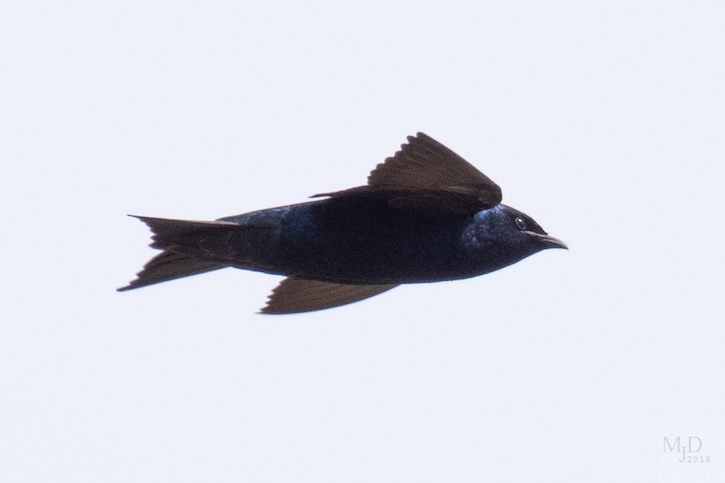
Purple Martin – Mike Densmore
On the island, we began with the Purple Martins at parking lot #1 of Parker River National Wildlife Refuge. The martins are well into breeding already, and it was pleasant as always to be with them and share their story with visitors. The Ospreys of the platform nest west of the parking lot were around the place, and Common Terns perched on pilings and flew over the water in the marsh. The ocean was mostly empty, save for a couple of loons and one tight raft of Black Scoters, who most likely were singing, unheard by humans as usual. We were aware of the Common Terns flying about as they have for a couple of weeks, when suddenly our hearts were lifted by the first squeaky-toy cries we had heard this year: Least Terns!
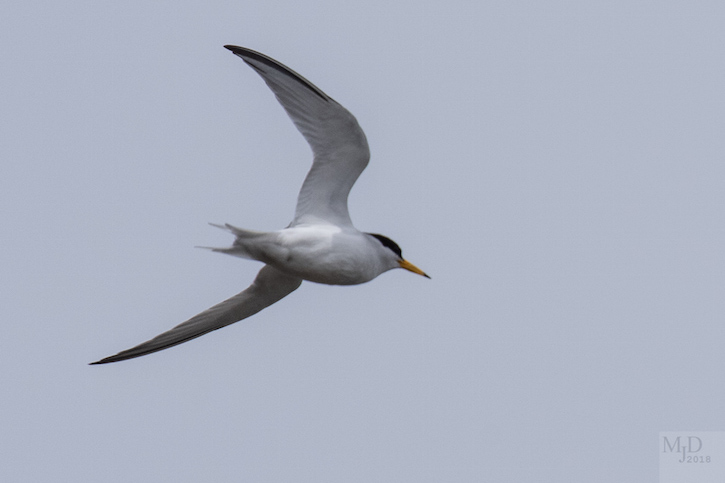
Least Tern – Mike Densmore
With that uplifting moment inspiring us, we hurried on to find Neotropical migrants. That is exactly what we did, mere moments after arriving at the Main Panne. While there was no horde of warblers there, participant Bob Minton and friends quickly turned up two Wilson’s Warblers that we were able to follow around for a while. Swallows flew purposefully north, nearly all Tree and Barn Swallows, with one buffy-rumped Cliff Swallow mixed in. (Note: Mass Audubon has decided to return to the convention of using capitals for species names, helping you to know that there is no species called “buffy-rumped cliff swallow”!) About 20 Semipalmated Sandpipers mixed with five or so Semipalmated Plovers and a Killdeer in the small flats at the north end of the panne. And what!? Wait! What’s that dingy, whitish, round-headed thing on the post out there in the marsh? It was a rather dusty-looking Snowy Owl, seen again late in the day, in no apparent hurry to return to the Arctic.
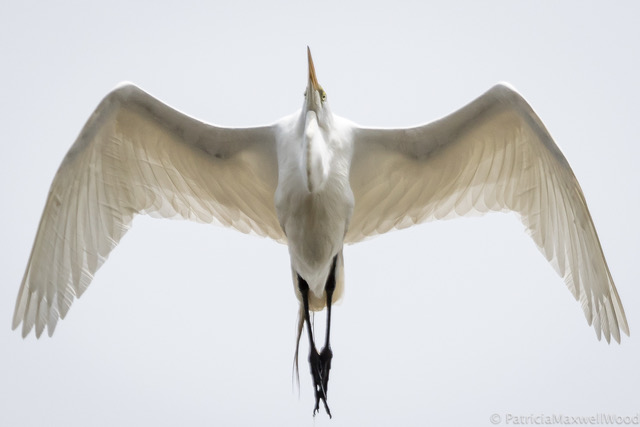
Great Egret – Patti Wood
We leaders, and a few others who had been birding every day lately, were a bit taken aback by the relative dearth of birds in the thickets, at least compared to the day before. So, we scurried on to the S-curves, where again, we found few birds. One 2nd-year male Orchard Oriole sang in front of many of us, and there was a bird here and there, but we had to keep moving. A Wild Turkey tom and hen were in The Warden’s Field, along with a Bobolink or two. When we bumped into Doug Chickering, he reported that there were warblers at Hellcat, but he had to “dig ’em up.”
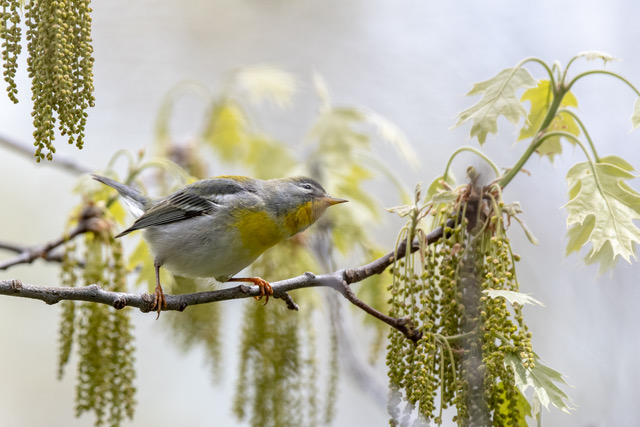
Northern Parula female – Bob Minton
Trying to picture “diggin’ up” warblers, we headed down to the Hellcat restroom area. Participant Sonia Krotkov identified another Wilson’s Warbler by song while we tried to glimpse the bird down in the bushes. But it wasn’t until we really got up on the dike to look down into the thicket that we started seeing Doug’s point. Several warblers – a male and a female Black-throated Blue, a Chestnut-sided, some Common Yellowthroats, an American Redstart, a Yellow, and the Wilson’s – all nearly slithered around near the ground, hardly ever even coming to the tops of the shrubs, let alone the trees! So when participant Susan Yurkus told us about the Blackburnian Warbler only 30 feet down the boardwalk, we decided to squeeze our group along the narrow planks for a bit. Birds were much more visible in there, and we enjoyed some good views of migrants, including orioles and a pretty female Rose-breasted Grosbeak.
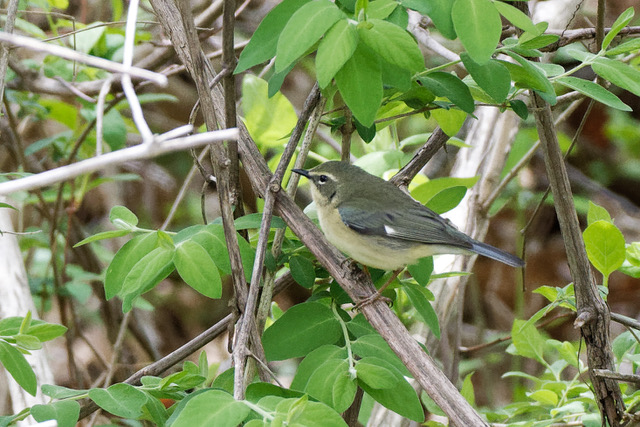
Black-throated Blue Warbler female – Bob Minton
I’m glad we had our “warbler spades” to help us with our digging this week, but I wonder what implement we will need next week to find the late migrants we expect. I hope it’s not a dragnet.
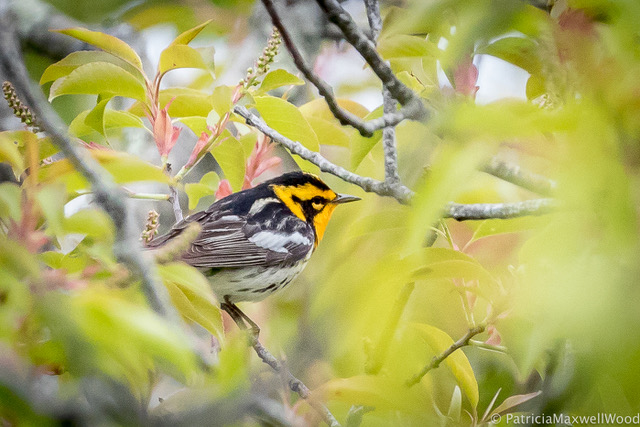
Blackburnian Warbler – Patti Wood
Our list:
Mute Swan (1) – marsh west of pannes.
Gadwall (2) – pair., pannes.
Black Scoter (~ 40) – parking lot #1 ocean.
Ring-necked Pheasant (1) – rooster crowing, PRNWR Visitor Center
Wild Turkey (2) – The Warden’s field.
Red-throated Loon (1) -parking lot #1 ocean.
Common Loon (1) -parking lot #1 ocean.
Double-crested Cormorant – common.
Great Egret (~ 6)
Snowy Egret (1)
Turkey Vulture (~ 7) – low over marsh north of Main Panne.
Osprey (2) – nesting platform west of parking lot #1.
Black-bellied Plover (1) – heard, Hellcat.
Semipalmated Plover (5) – north end main panne.
Killdeer (3)
Greater Yellowlegs – common.
Willet – common.
Lesser Yellowlegs – common.
Semipalmated Sandpiper (~ 20) – north end Main Panne.
Least Sandpiper (2) -north end Main Panne.
Herring Gull
Great Black-backed Gull
Least Tern – common.
Common Tern – common.
Rock Pigeon
Mourning Dove
Snowy Owl (1) – west of small pannes.
Ruby-throated Hummingbird (1)
Red-bellied Woodpecker (2) – 1, S-curves; 1, Hellcat.
American Kestrel (1) – perched in North Field copse.
Merlin (1) – mad dash south over middens.
Least Flycatcher (1) – S-curves.
Great Crested Flycatcher (1) – Hellcat.
Blue-headed Vireo (1) – Hellcat.
Blue Jay (2) – Hellcat.
Purple Martin (~ 12) – parking lot #1.
Tree Swallow – common.
Cliff Swallow (1) – pannes.
Barn Swallow – common.
Black-capped Chickadee (2) – Hellcat.
American Robin (3)
Gray Catbird – common.
Northern Mockingbird (1) – at head of Hellcat parking lot.
Brown Thrasher (2)
European Starling
Northern Waterthrush (1) – Hellcat.
Black-and-white Warbler (1) – S-curves.
Common Yellowthroat – common.
American Redstart (4) – various.
Northern Parula (~ 5) – various.
Blackburnian Warbler (1) – Hellcat.
Yellow Warbler – common.
Chestnut-sided Warbler (1) – Hellcat restrooms.
Black-throated Blue Warbler (5) – Hellcat.
Black-throated Green Warbler (1) – Hellcat.
Wilson’s Warbler (3) – 2, thicket east of pannes; 1, Hellcat.
Northern Waterthrush (2) – 1, S-curves; 1, Hellcat.
Eastern Towhee – common.
Field Sparrow (2) – 1, north end S-curves; 1, vicinity of Hellcat.
Song Sparrow (~ 7) – various.
White-throated Sparrow (1) – Hellcat.
Northern Cardinal (2)
Rose-breasted Grosbeak (2) – Hellcat.
Bobolink (4) – North Field.
Red-winged Blackbird – common.
Common Grackle – common.
Brown-headed Cowbird – common.
Orchard Oriole (1) – S-curves.
Baltimore Oriole (~ 7) – various.
Purple Finch (~ 5) – S-curves & Hellcat.
American Goldfinch (~ 5)


Terrific Wednesday Morning, and awesome photos Mike, Patti, Bob. A little short on warblers, though. Maybe the tail end with some like Magnolias, Bay-breasted, Palm and Blackpoll already through? Nice to see 2 thrashers on the list.